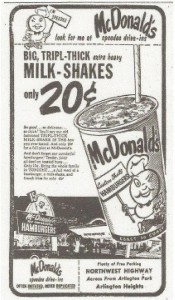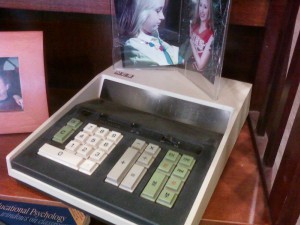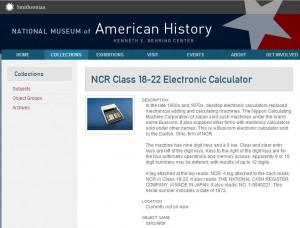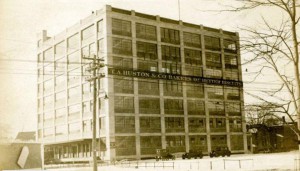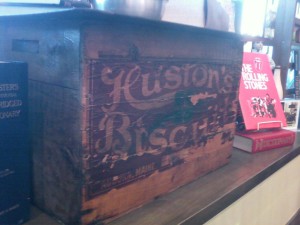Before Ronald there was a big hamburger-headed guy in a chef’s hat holding a placard that read: 15¢ (I had to Google the method for inserting a cents sign “¢” – Sheesh. Not on the keyboard anymore.)
I was doing a little research in a newspaper database when I ran across the ad from 1959. The little hamburger-man has on his sign: I’m Speedee.
And I guess that was his name.
As you can see, some things have changed from that year. The BIG TRIPL-THICK extra heavy MILK-SHAKES aren’t 20¢ any longer. And the dinner suggestion? (The fine print in the ad that didn’t reproduce so well from the newsprint archive.) That reads:
And don’t forget our wonderful hamburgers! Tender, juicy all-beef on toasted buns. Only 15¢. Bring the whole family in TONIGHT… a full meal of a hamburger, a milk-shake, and French Fries for only 65¢
Look for me at Speedee McDonald’s drive-ins, he says.
Since there is little risk of dating myself further than I already have on these webpages, I’ll admit that my earliest memories of McDonald’s were of a location that looked like the one in the image. 15¢ burgers.
We were late to the McDonald’s location club when I graduated high school at McAlester. More than likely, Tulsa had the nearest location. As an underclassman in high school at Joplin, one of the seniors bet another that he could easily eat a $50 meal. I’m sure he was thinking prime rib or Surf & Turf, and the idea that the bill for such a meal could easily run to that amount.
His wiseacre buddy (you guessed it) stopped the car at McDonalds. As you might imagine, there was no way that he made it through even ten bucks worth of burgers. (That would have been about 65 of those tender, juicy, all-beef jobbers.)
Another thing I’ve learned as a result of researching over the years. You can’t always believe what you read on the internet. A McDonald’s WIKI listing says that the Golden Arches date to 1962, but they are clearly visible in the 1959 newspaper ad background.
Something you may not have known – the restaurant was founded in 1940 as a barbecue spot, by Maurice and Richard McDonald. It was Ray Kroc that took them nationwide and later bought out the brothers.
Speedee was retired in 1967 when Ronald McDonald donned his red nose and baggy pants.
The clown has long-outlived the 15¢ hamburger and the 20¢ Tripl-Thick Milk-Shake.
Don’t have burgers here, but we have some tasty, hand-prepped sandwiches made to order. Don’t even own a heat lamp. And Dustin’s Chalkboard Special today – quesadillas with handmade guacamole and salsa and borracho beans… South of the Irish Border, and… Delicious!
Come visit!
McHuston
Booksellers & Irish Bistro
Rose District
122 South Main St. Broken Arrow OK!

